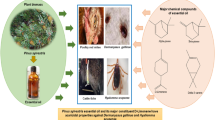Abstract
Untreated eggs of the tick Amblyomma hebraeum Koch (Acari: Ixodidae) exhibited antimicrobial activity (AMA) against Gram-negative but not Gram-positive bacteria; eggs denuded of wax by solvent extraction showed no AMA. The unfractionated egg wax extract, however, showed AMA against Gram-positive but not Gram-negative bacteria, as also shown by Arrieta et al. (Exp Appl Acarol 39: 297–313, 2006). In this study we partitioned the egg wax into various fractions, using a variety of techniques, analyzed their compositions, and tested them for AMA. The crude aqueous extract exhibited AMA. However, although more than 30 metabolites were identified in this extract by nuclear magnetic resonance analysis, none of them seemed likely to be responsible for the observed AMA. In the crude organic extract, cholesterol esters were the most abundant lipids, but were devoid of AMA. Fatty acids (FAs), with chain lengths between C13 and C26 were the next most abundant lipids. After lipid fractionation and gas chromatography/mass spectroscopy, free FAs, especially C16:1 and C18:2, accounted for most of the AMA in the organic extract. The material responsible for AMA in the crude aqueous extract remains unidentified. No AMA was detected in the intracellular contents of untreated eggs.




Similar content being viewed by others
References
Arrieta MC, Leskiw BK, Kaufman WR (2006) Antimicrobial activity in the egg wax of the African cattle tick Amblyomma hebraeum (Acari: Ixodidae). Exp Appl Acarol 39:297–313
Booth TF (1992) Observation on the composition and biosynthesis of egg wax lipids in the cattle tick, Boophilus microplus. Exp Appl Acarol 14:137–149
Booth TF, Beadle DJ, Hart RJ (1986) The effects of precocene treatment on egg wax production in Gené’s organ and egg viability in the cattle tick Boophilus microplus (Acarina ixodidae): an ultrastructural study. Exp Appl Acarol 2:187–198
Desbois AP, Smith VJ (2010) Antibacterial free fatty acids: activities, mechanisms of action and biotechnological potential. Appl Microbiol Biot 85:1629–1642
Esteves E, Fogaca AC, Maldonado R, Silva FD, Manso PPA, Pelajo-Machado M, Valle D, Daffre S (2009) Antimicrobial activity in the tick Rhipicephalus (Boophilus) microplus eggs: cellular localization and temporal expression of microplusin during oogenesis and embryogenesis. Dev Comp Immunol 33:913–919
Friesen KJ, Kaufman WR (2002) Quantification of vitellogenesis and its control by 20-hydroxyecdysone in the ixodid tick, Amblyomma hebraeum. J Insect Physiol 48:773–782
Graeve M, Janssen D (2009) Improved separation and quantification of neutral and polar lipid classes by HPLC–ELSD using a monolithic silica phase: application to exceptional marine lipids. J Chromatogr B 87:1815–1819
Kaufman WR (2007) Gluttony and sex in female ixodid ticks: how do they compare to other blood-sucking arthropods? J Insect Physiol 58:523–536
Kaufman WR, Phillips JE (1973) Ion and water balance in the ixodid tick Dermacentor andersoni: routes of ion and water excretion. J Exp Biol 58:523–536
Lees AD, Beament JW (1948) An egg-waxing organ in ticks. Quart J Micro Sci 89:291–322
Lynch DV, Steponkus PL (1987) Plasma membrane lipid alterations associated with cold acclimation of winter rye seedlings (Secale cereale L. cv Puma). Plant Physiol 83:761–767
Ment D, Gindin G, Glazer I, Perl S, Elad D, Samish M (2010) The effect of temperature and relative humidity on the formation of Metarhizium anisopliae chlamydospores in tick eggs. Fungal Biol 114:49–56
Myher J, Kuksis A, Pind S (1989) Molecular species of glycerophospholipids and sphingomyelins of human plasma: comparison to red blood cells. Lipids 24:408–418
Nakajima Y, Ishibashib J, Yukuhiroc F, Asaokab A, Taylora D, Yamakawa M (2003) Antibacterial activity and mechanism of action of tick defensin against Gram-positive bacteria. Biochim Biophys Acta 1624:125–130
Otvos L, Cudic M (2007) Broth microdilution antibacterial assay of peptides. Methods Mol Biol 386:309–320
Potterat O, Hostettmann K, Höltzel A, Jung G, Diehl P, Petrini O (1997) Boophiline, an antimicrobial sterol amide from the cattle tick Boophilus microplus. Helv Chim Acta 80:2066–2072
Psychogios N, Hau DD, Peng J, Guo AC, Mandal R, Bouatra S, Sinelnikov I, Krishnamurthy R, Eisner R, Gautam B, Young N, Xia J, Knox C, Dong E, Huang P, Hollander Z, Pedersen TL, Smith SR, Bamforth F, Greiner R, McManus B, Newman JW, Goodfriend T, Wishart DS (2011) The human serum metabolome. PLoS ONE 166:e16957. doi:10.1371/journal.pone.0016957
Schöl H, Sieberz J, Göbel E, Gothe R (2001) Morphology and structural organization of Gené’s organ in Dermacentor reticulatus (Acari: Ixodidae). Exp Appl Acarol 25:327–352
Wishart DS, Lewis MJ, Morrissey JA, Flegel MD, Jeroncic K et al (2008) The human cerebrospinal fluid metabolome. J Chromatogr B Analyt Technol Biomed Life Sci 871:164–173
Acknowledgments
The visit of Zhijun Yu to the University of Alberta was generously supported by China Scholarship Council and Hebei Normal University. We are grateful to (1) Mr. Audric Moses of the Lipid and Lipid Metabolite Analysis Core Facility, a service of the Women and Children’s Health Research Institute at the University of Alberta, for GC analysis of the organic extract, (2) to Mr. Ramanarayan Krishnamurthy and Ms. Rupasri Mandal of The Metabolomics Innovation Centre, U Alberta for the GC/MS and NMR analyses respectively of FAs, and (3) Mr. Troy Locke, Mr. Alexander Smith, Mr. Shahid Ullah, and Dr. Susan Jensen from the Department of Biological Sciences, for general advice and assistance throughout this study. This research was generously supported by a Discovery grant to WRK from the Natural Sciences and Engineering Research Council of Canada (NSERC). Dr. René Jacobs is a Canadian Institutes of Health Research New Investigator.
Author information
Authors and Affiliations
Corresponding author
Rights and permissions
About this article
Cite this article
Yu, Z., Thomson, E.L.S., Liu, J. et al. Antimicrobial activity in the egg wax of the tick Amblyomma hebraeum (Acari: Ixodidae) is associated with free fatty acids C16:1 and C18:2. Exp Appl Acarol 58, 453–470 (2012). https://doi.org/10.1007/s10493-012-9586-1
Received:
Accepted:
Published:
Issue Date:
DOI: https://doi.org/10.1007/s10493-012-9586-1




